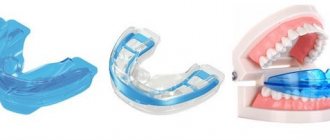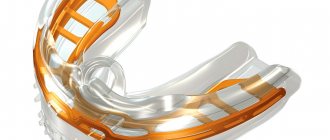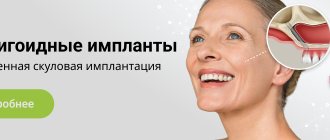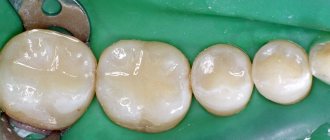Signs of TMJ inflammation
Many people do not pay attention to clicks, crunching sounds, and discomfort when opening and closing their mouth that appear in the TMJ. This happens only until the problem becomes chronic or reaches an acute stage. The following signs are characteristic:
- periodic pain in the jaw joints;
- feeling that some facial muscles are stiff;
- causeless headaches;
- limited joint mobility (inability to fully open or close the mouth);
- discomfort in the neck and back;
- stuffy ears.
Care of mouthguards.
In order for your mouthguards to last you a long time, you need to take care of them daily. Due to poor hygiene, they can provoke the spread of pathogenic bacteria. The following rules will help prevent the risk of an inflammatory process and keep the structure in proper form:
- Before and after using the trays, they should be washed with a special rinse aid and stored in a container.
- If cracks or scratches appear on the surface of the product, it should be replaced with a new one.
- Do not place them in hot water, do not expose them to too high or low temperatures.
What is a release guard?
This is a removable orthodontic structure, which is used in dentistry to relieve tension in the jaw muscles and return the lower jaw to the correct position. A mouthguard is an elastic and transparent overlay for teeth, made individually based on casts of the jaws of a particular patient. It is almost invisible in the mouth.
Such designs are used to correct various malocclusions - moving teeth to the correct position. The disconnecting mouth guard not only moves teeth, but also has a number of other functions:
- normalizes neuromuscular balance, relieving excessive muscle tone;
- stabilizes joints for proper functioning of the lower jaw;
- harmoniously distributes the load on muscles, ligaments, joints;
- changes the trajectory of jaw movement;
- Centers the lower jaw, returning it to its correct position.
Purpose, reasons for violations
Mouthguards are one of the elements of the therapeutic course prescribed for diagnosing pathologies of the functionality of the temporomandibular joint. The department with the greatest mobility in the entire human body ensures the performance of basic tasks such as chewing, speech, respiratory function, etc. Numerous muscles and ligaments are exposed to stress every day, and in the presence of anatomical defects, the resulting tension can persist even during a period of rest, which affects the state of the bite and also provokes negative symptoms.
Incorrect functioning of the masticatory muscles provokes problems such as:
- Deviation in the development of bite;
- Partial or complete restriction of jaw mobility;
- Accelerated erosion of tooth enamel;
- Defragmentation of fillings and crowns;
- Diction problems;
- Headaches and cramps;
- Sleep disorder.
Factors causing TMJ dysfunction have different origins. In some cases, the cause of the pathological condition is constant stress - psychological tension forces the patient to involuntarily clench his teeth, which leads to overload of the muscle structure. A separate pathology of this nature - bruxism - still remains the subject of research aimed at identifying the root cause of its occurrence. In addition, the functionality of the dentofacial apparatus is directly affected by the anatomical arrangement of the elements of the dentition - the displacement of individual units leads to a violation of occlusion.
A mouth guard for muscle relaxation relieves hypertonicity, restores balance, and helps normalize the relationship between the upper and lower jaw. In addition, wearing can be indicated before correcting the bite with braces, installing dentures, as well as during the rehabilitation period after receiving mechanical injuries and damage.
How are release guards made?
In the manufacture of mouth guards, diagnostics plays an important role, since before treatment, a multifaceted functional analysis and accurate calculation are needed. The patient undergoes a computed tomography (CT) examination, as a result of which the doctor receives data on the condition, structure, and anatomical features of the TMJ, muscles, and ligaments. Various studies are used to determine the optimal position of the lower jaw. For example, in some clinics they use physiotherapeutic devices that relax the head muscles and identify disorders that prevent the formation of a normal bite.
The mouthguard is then made in the laboratory using impressions of the patient's jaw. The doctor first calculates the trajectory of movement of the teeth and jaw. It occurs gradually, softly and delicately, unnoticed by the patient himself.
Production of caps
Their production does not take much time, it is carried out in the shortest possible time from 2 to 5 days. Let's take a closer look at the process of their creation:
- First you need to take a cast of the jaw. The dentist fills the impression tray with a special elastic mass and fixes it in the patient’s mouth. After clenching the teeth, the impression is ready.
- Next, you need to cast a plaster model using the casts obtained.
- Most often, bioplastic or biosilicone is chosen for their base. The properties of these materials allow the structure to adhere more reliably and firmly to the dentition. In his work, the technician uses a molding apparatus in which special conditions are created - the temperature reaches +140 degrees and the pressure is 5-6 atmospheres. Under such influence, a mouth guard against bruxism is produced. Its inner part is made soft so as not to accidentally injure the mucous membrane, and the outer part, on the contrary, is harder, because it is designed to perform protective functions. The finished product is laminated and sent to the dentist.
- On the appointed day, the doctor checks the correct manufacture of the system by trying it on the patient. If he finds any inaccuracies, it will be sent for revision. When installing it, it should be easy to take off and put on, so that a person will not have any difficulties in using it in the future.
Wearing Features
The disconnecting mouthguard is practically invisible on the teeth; it is worn constantly, removing it only when eating. In some cases, it is enough to wear the structure only while sleeping. The wearing mode is determined by the orthopedic dentist. Since the material is quite thin and elastic, the patient’s diction is preserved. The mouthguard may cause discomfort only in the first days when addiction occurs.
Every 2-3 weeks you need to visit an orthopedist so that he can monitor the progress of treatment and adjust the mouth guard. Usually it is worn for 4-6 months; in complex cases, treatment can take up to a year.
RECOMMENDATION: HOW TO CARE FOR A DISCLOSING MOUTH
Twice a day, during your usual hygiene procedures, you need to rinse the structure with warm, but not hot water, removing plaque with a regular toothbrush. In this case, it is optimal to use toothpaste or antibacterial agents recommended by the dentist. The mouthguards are stored in special containers.
Expected Result
In the first time after the start of treatment, results are noticeable , pain and tension disappear. With prolonged use, the teeth gradually fall into place and the bite is evened out.
The joint begins to work correctly, the load decreases and a gradual improvement in the condition begins. Bruxism reduces the wear of enamel.
The treatment period can last up to one and a half years, and it is necessary to take into account some possible complications, such as loose teeth and caries. But they can be avoided if you follow all the doctor’s recommendations and properly care for your teeth and the disconnecting mouth guard.
The video presents the patient's opinion about the effectiveness of the disconnecting mouthguard in getting rid of a crunching sensation in the jaw.
An unloading splint helps:
- relax the muscles before performing prosthetics, volumetric restorations;
- protect crowns and fillings after treatment, extend their use;
- get used to the new crowns faster and provide greater comfort in wearing them;
- eliminate the feeling of tension in the masticatory muscles, pain when chewing, clicking and pain in the joint, headaches, sleep disturbances, etc. associated with hypertonicity of the masticatory muscles;
- convenient to whiten teeth at home, maintain color after professional whitening;
- protect your teeth during active sports;
- prevent further tooth wear
Reviews
In general, a decoupling mouthguard helps to cope with a variety of problems associated with the functioning of the jaw apparatus.
People's opinions may vary, since wearing a structure has its advantages and disadvantages, but in most cases the result justifies all the inconveniences.
You can share your opinion about the effectiveness of the disconnect mouth guard and leave feedback in the comments to this article.
If you find an error, please select a piece of text and press Ctrl+Enter.
Tags: mouthguard bite correction
Did you like the article? stay tuned
No comments yet
Why are unloading trays needed:
We live in a metropolis.
The big city dictates its own rules. High pace of life, a huge number of business meetings, minimum free time and maximum physical and emotional output. Little by little, fatigue accumulates, psycho-emotional reserves are depleted, and chronic stress quietly arises. “What does teeth have to do with it?” - you ask. If you listen carefully to your body, the dental system can be the first to tell us about a critical situation. The fact is that under stress our muscles are in hypertonicity - excessive tension. Including the chewing muscles. Prolonged exposure to stress causes:
- pain when chewing
- clicking and pain in the joint
- headaches, sleep disturbances, etc.
Increased muscle tone leads to:
- to increase the force of teeth clenching. Your family may tell you that you started grinding your teeth in a dream. You yourself can see and feel these changes.
- teeth wear out, their shape changes, they become shorter.
- Fillings and crowns may chip.
- with significant abrasion, the proportions of the face change and nasolabial folds appear. Such faces look much older than their years.
Types of devices
There are two categories of mouthguards used to correct and eliminate defects in the jaw row:
- Relaxation products – products whose functional task is to restore natural muscle tone and eliminate excess tension that arises due to incorrect anatomical relationship of the jaws;
- Stabilizing devices are devices designed to correct the position of the mandibular region, as well as subsequently consolidate the achieved result.
The criteria used within the orthodontic classification also include an age aspect (adults and children's mouth guards). It is worth noting that, despite the differences in the rigidity of the structures, the list of functional tasks solved during the treatment process remains similar:
- Centering of the mandibular region;
- Correct redistribution of mechanical pressure;
- Preparation for correction using braces;
- Correcting the position of individual row elements;
- Bite separation for therapeutic treatment.
The selection of a suitable mouth guard is based on the results of a preliminary examination and takes into account the specifics of the diagnosed anomaly or pathology.











